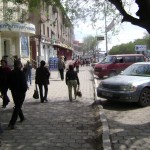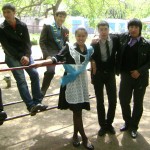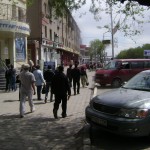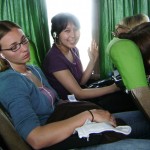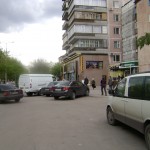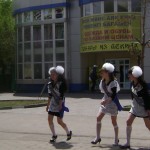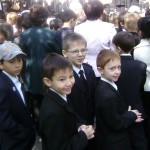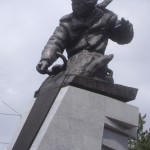Karaganda is a fascinating place:
Category Archives: Uncategorized
Kazakhstan — Underexposed by Design
 Fearlessness is helpful in a journalist. For photojournalists – especially those working abroad – it is mandatory. This is becoming clearer every day here in Kazakhstan, a place where cameras seem as welcome as American robber-barons would have been in Moscow in 1917.
Fearlessness is helpful in a journalist. For photojournalists – especially those working abroad – it is mandatory. This is becoming clearer every day here in Kazakhstan, a place where cameras seem as welcome as American robber-barons would have been in Moscow in 1917.
Our photojournalism students are having their mettle tested here. Repeatedly, as they try to shoot in seemingly public places, they are waved off. Scary-looking security guards pop out of buildings, flailing their arms and jabbering away in Russian or Kazakh to tell them “no pictures.” The other day, as all eight students and I approached an indoor market area, a guard radioed to a colleague perched on a rooftop high above us. Roofman formed X signs with his arms to make it clear that no snapping was allowed. And all we wanted was lunch!
Fortunately, the students are rising to the challenge. They are using friendly smiles, charm and a certain fearlessness to disarm reluctant subjects and persuade them they mean no harm. Yesterday, as Patrick Breen was shooting fortune-tellers near the Green Market he managed to stave off some character who was accusing him and Elizabeth Gamez of being from the FBI and somehow helping foment a Kyrgyzstan-style revolt. They also persuaded a fortune-teller to let Patrick photograph her (in a scarf above) even though many of her colleagues protested the attention. (Patrick’s fortune looks bright, by the way, she told him).
 People do usually welcome our students once they understand what they’re up to. With the help of one of our guides, Travis Beck got one of the photos attached here at a “family home,” a kind of orphanage located in Talgar, 20 kilometers east of Almaty. Director Eskozhina Tuyak, smiling over the bread, was happy to tell him about the place – called “Nur,” Kazakh for sunlight – which houses some 66 college students, some married couples and others. Some 110 people aged 4-25 live at the place, which Tuyak started in 1998 by selling her personal apartment. She worked in the state’s ministry of education for 43 years.
People do usually welcome our students once they understand what they’re up to. With the help of one of our guides, Travis Beck got one of the photos attached here at a “family home,” a kind of orphanage located in Talgar, 20 kilometers east of Almaty. Director Eskozhina Tuyak, smiling over the bread, was happy to tell him about the place – called “Nur,” Kazakh for sunlight – which houses some 66 college students, some married couples and others. Some 110 people aged 4-25 live at the place, which Tuyak started in 1998 by selling her personal apartment. She worked in the state’s ministry of education for 43 years.
This is a country of many contradictions. On the one hand, people could not be more hospitable. Our waitress in an Internet coffeeshop, for instance, went out of her way yesterday to help us get a ride to our next appointments, visits to the Internews press-advocacy group and the Kazakh Stock Exchange. And folks there, similarly gracious, helped us get back on an exchange bus. We wander about at will, with no one holding us back or shadowing us. Travis was also able to photograph a group of children at play, below.
On the other hand, it’s a place where security concerns loom large, often pointlessly so. The hostility to cameras, for example, is widespread. Signs in restaurants bar photography. People in cafes gesture “no” with their hands and shake their heads when our students point cameras at them. No photographs are permitted, we were told, during trading hours at the stock exchange – only shots of the empty trading floor after hours.
 Theft is not uncommon, we’re told. Don’t hand your cameras over to anyone to shoot your picture because they’ll take a flier with your gear. And yet, the common way of getting around is taking what our kids call “random cabs,” standing in the street and holding your hand low until some random person picks you up and you negotiate a ride around the city – always under 500 tengey (about $3.25). It’s common for women to accept such rides well into the evenings, and we took a couple random cabs yesterday.
Theft is not uncommon, we’re told. Don’t hand your cameras over to anyone to shoot your picture because they’ll take a flier with your gear. And yet, the common way of getting around is taking what our kids call “random cabs,” standing in the street and holding your hand low until some random person picks you up and you negotiate a ride around the city – always under 500 tengey (about $3.25). It’s common for women to accept such rides well into the evenings, and we took a couple random cabs yesterday.
It’s as if there’s a blend of Central Asian tribal hospitality and Soviet-style state paranoia. Since the country was a part of the USSR until the early 1990s and remains heavily Russified, worries about security and a need for control seem to be woven into the cultural DNA. Why does our nearby indoor supermarket have three guards, one stationed near the entrance and two just outside the cash register area, even as one or two more stand sentry at the mall entrance? Why do buildings under construction need guards in their lobbies? Why do police cruise the streets at night, pulling people over for U turns on deserted stretches of road or checking IDs? And why is Google’s eblogger seemingly jammed?
Certainly, security worries are a big part of the American experience, especially since 9/11. Think about how guards now roam with abandon across all areas of American life and security has become a huge industry, going far beyond the airports. New Yorkers are considering putting virtually every street under surveillance. And plenty of American institutions, such as corporations and government bodies, bar press photography on their premises unless it’s under tight control. Here, though, it’s security on steroids, whether justified or not, and without the newest technology.
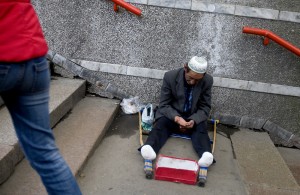 Another thing that has struck us is the lack of homeless people. This plague, rife in American and European cities alike, seems not to be an issue here in Almaty. We have seen none. Partly, we’re told, this is because people are family oriented here and take care of their own. Partly it may be because mentally incompetent people are confined by the state, as they once were in the U.S. There are a few scattered beggars – see Patrick’s photo of one unfortunate footless man – but no bedrolls in the parks or people pushing grocery carts. Poverty is an issue, to be sure, but its human face in the city seems less obvious.
Another thing that has struck us is the lack of homeless people. This plague, rife in American and European cities alike, seems not to be an issue here in Almaty. We have seen none. Partly, we’re told, this is because people are family oriented here and take care of their own. Partly it may be because mentally incompetent people are confined by the state, as they once were in the U.S. There are a few scattered beggars – see Patrick’s photo of one unfortunate footless man – but no bedrolls in the parks or people pushing grocery carts. Poverty is an issue, to be sure, but its human face in the city seems less obvious.
So I must admire our student photographers. They are managing through these challenges, finding fresh ways to show life in this fascinating society. Our work, of course, should be helpful to the place, as we tell readers about how ordinary Kazakhs go about their days – whether they run apple orchards and brokerage operations or pray in the mosque or, as in Patrick’s photo below, play with pigeons.
As they rove around, cameras in hand, the students are surmounting all sorts of obstacles. Language difficulties, transportation challenges and persuasion of reluctant sources. It all demands a bit of nerve, and they are summoning it in spades.
Quotron, E.F. Hutton and the Future of Newsweek

[another piece from the Tabb Forum series:]
For folks in finance, change is nothing new. They’ve long watched technology race ahead and markets shift, long been subject to tectonic changes that left stock exchanges and investment banks to adjust or die. Their world is littered with such relics as stock-quote tapes and Quotron devices, along with fading memories of once-titanic names (remember E.F. Hutton and Paine Webber). Wall Streeters have learned to roll with the punches.
But for those in the media business, change is surprisingly difficult. Newspapers, magazines and even TV networks become “venerable” after a few decades, and they are thought to be immortal, at least by others in the biz. Most of the scribblers who people the offices of the leading media outfits believed – until recently at least – that their institutions would far outlast them. Storied names, such as Newsweek or BusinessWeek, would never go away.
As the Washington Post Co.’s move to put Newsweek on the block shows, however, nothing in any business really lasts forever. Creative destruction is the way of capitalism, whether on the floor of the New York Stock Exchange or in the offices of a weekly news magazine. Newsweek has been eclipsed by the Net, just as the historic role of specialists has been made all but irrelevant by electronic trading. The weekly could easily go the way of Life and Look magazines, pubs done in by TV and the popularization of cameras.
Will Newsweek survive under a new owner? Maybe. Surely, some wealthy character eager to burnish his or her global rep will snap it up for the power and influence it still commands – at least for now. It will likely become a plaything for some mogul, perhaps a Chinese or Middle Eastern potentate, who wants the access to political leaders the media still brings. Almost surely, it will have to be someone who doesn’t mind losing a lot of money on the mag as a tradeoff for the benefits that come along with a big media property.
But will the product be the same? And will it endure? Certainly, a new owner would make a mark on the magazine, for good or ill. In Newsweek’s case I fear that it will be for ill, since the folks there now have a pretty good idea of how to produce a quality newsweekly. Adding to what they already do well – or, more likely, cutting – could be problematic. The people there now are pros and tinkering with their approaches seems doomed to come to grief.
Of course, it all depends on the owner. Bloomberg bought BusinessWeek last fall and, so far, has managed to make some notable improvements. The editors, by reaching into BW’s past and adding some nifty contemporary touches, are turning out a product that boasts of lots of promise again. It’s a far better book than the thin glossies that have marked the last few years. Editorially, Bloomberg’s market-savvy journalists add value, and the parent’s financial backing may just see the pub through until advertisers want in again. However, it’s an open question whether BW’s cachet and exposure to 4.5 million readers – taking the Bloomberg name to more places than the outfit reaches through its 300,000 terminals – will need to be underwritten forever.
Newsweek is a tougher case. So many news organizations are so hard-pressed that it’s tough to see which could be a natural buyer. The synergy issue is crucial. And non-news owners – the moguls – may tire of their toy quickly, especially if they add no real value. Worse, its readership could fast erode, as the Net’s inexorable march proceeds. Yes, the staff will produce versions for the iPad, Kindle or Nook that readers can buy. But will the public want the book even then? While BW does add value for a specialized audience – folks in the capital markets can attest to that – Newsweek by definition serves a broad audience. The mass market seems far less interested in its kind of journalism anymore. Instead, it prizes immediacy and multi-media approaches.
In the end, imagination and technology will dictate the future for people in finance and media alike. The adjustment can be brutal – just ask the scores of talented people BW and Newsweek have lost in the last couple years. Or ask all those bright folks who once populated the mighty investment banks that no longer stride the earth, gone the way of the dinosaurs. Standing outside the process, it becomes clear that the public is better served after the system’s creative destruction has reshaped things. But, now, in the middle of it, it’s hard to see little but rough road ahead for a while. To the good folks of Newsweek, godspeed.
The New BW: Something Old, Something New, Something Borrowed …
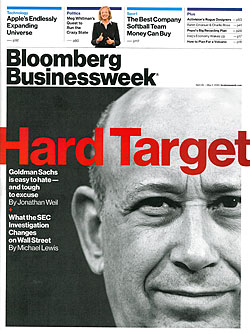 The new BusinessWeek, rechristened Bloomberg Businessweek, surged into mailboxes and onto newsstands in the last few days. Months in the making, the newest version of the magazine reflects the strengths of both the pub’s 80-year history and its new 1,700-journalist supporting staff. It also boasts a knockout layout, in some ways a return to the substance and elegance of the mag’s heyday of the 1990s with a contemporary gloss.
The new BusinessWeek, rechristened Bloomberg Businessweek, surged into mailboxes and onto newsstands in the last few days. Months in the making, the newest version of the magazine reflects the strengths of both the pub’s 80-year history and its new 1,700-journalist supporting staff. It also boasts a knockout layout, in some ways a return to the substance and elegance of the mag’s heyday of the 1990s with a contemporary gloss.
Indeed, the book overall is a refreshing mix of what made BW a winner in the past and some nice new touches. The Back to the Future treatment includes savvy analysis, depth and graceful writing, combined with a renewed focus on corporations, the finance world and politics. It’s a must-read once again! After too many years of thin books with too little to dine on, this new offering is a full-course meal again – complete with dessert (read on for that).
The new BW isn’t perfect. The Global Economics pages are a confusing jumble, the small-biz section needs work and at least one columnist is off the mark. But the mag overall is sleek and smart and gives readers some insights they won’t get elsewhere – which in the end has always been BW’s drawing card. After all, if the fish isn’t fresh, the wrapper hardly matters, no?
For a page-turning look, check here.
Overall, give this effort a B+, with expectations that As are on the way in future issues. Here are some specifics from a close review by an admittedly biased veteran:
COVER – Clean, dramatic, inviting. Love the powerful photo of Blankfein looking at once like he has only contempt for his critics even as he sorely needs a shot of Pepto-Bismol. “Hard Target” is a great Cover Line. All the white in the boxes and flag at the top seems a bit busy, though. Giving “Bloomberg” equal play with “Businessweek” in the flag is understandable politically, but it makes for a lot of crowded type in the top half of the cover. Grade: B+
CONTENTS PAGE – Knockout presentation. Well-arted and conveys substance.Grade: A
MASTHEAD – Nice to see it back after too long of an absence. The editor’s letter should appear regularly to draw attention to stories behind the stories. It lets readers connect with the writers and editors. Sadly, the staff is a shadow of the force it once was, but the Bloomberg global correspondent system is already bringing some depth not apparent from the masthead. Grade: B
INDEX – what is the point of the Robot Bully? Cartoon is a great idea. This execution is pointless. Find something original. Grade: C
OPENING REMARKS – Well done. This Economist takeoff, an editorial commentary on a story developed later in the book, brings to bear one of the key strengths of magazines: a clear point of view. The pieces here take readers beyond the daily paper – further beyond even than the stories — giving them a reason to read yet another piece about the big news of the day. Props, too, on the future spin in the Weil piece. Love both the Weil and Lewis treatments. Grade: A
GLOBAL ECONOMICS – Disappointing. It seems like a catch-all, a section in newspapers we used to call the “slop page.” Yes, variety can be intriguing. But the Iraq piece is flat and the timeline ridiculously thin and pointless, though nicely colorful. Loved the volcano and Greek crisis pieces, which had the virtue of timeliness. Seems like a more coherent focus on the economically oriented news of the week would work. But it’s hard to see any focus in the section – certainly economics is not what it’s about. And just why is a tractor cruising at the top of page 19? Seems to invite you to look ahead if you are bored with this page. Grade: D
COMPANIES & INDUSTRIES – Heart of the book. BW’s core franchise has been corporate coverage, though it got short shrift in recent years. It’s what employees, managers, shareholders and business partners of companies care about; a natural reader base. You’ve given the section its due here. Intriguing pieces about brand-name companies, with lots of variety, makes this a winning area. BW’s dismantled bureau network – a sad loss — would have been a key asset in putting this section together, and the job now falls to Bloomberg folks and skilled editors in NYC. Grade: A
POLITICS & POLICY – Smart and lively. Again, a core strength of the old BW given its due anew. Love the Emanuel Q&A and the Reshuffle in Obama Land. Why, though, is Zynga overlooking page 38? And James Warren’s column seems to come out of nowhere. Grade: A
TECHNOLOGY – A core franchise of the old BW, reborn. Yes, yes, yes, give us more, since this is the engine of the American economy. Traditionally, BW led the pack in tech and it would be nice to see it do so again. Grade: A
MARKETS & FINANCE – Another franchise area. Top-flight coverage of this crucial sector of the economy is central. Should be mandatory every week, along with Tech and Corp. Smart takes on Goldman here. Would have been nice to have a takeout on the new regulatory bill, however, since it looms large and scary on the horizon. Maybe next week. Grade: A-
ENTERPRISE – Winning idea. But the focus on the lede story is problematic. Is this about B&J or principles or payouts or what? Seems to stray. Whole section does, in fact. Small-biz is often a mixed-bag. Seems like a good idea, but it will be tough to execute well. Don’t get the point of Wadhwa’s column at all: does it just celebrate Boulder or offer a skimpy roadmap on how to duplicate it? Topic deserves a whole section, not just the once-over-lightly here. Grade: B-
FEATURE WELL – Whitman piece is interesting but could have been twice as good at half the length. Apple piece by Burrows, a pro, is superb and takes us well beyond the news – a classic BW treatment. And The City That Got Swapped is excellent, top-drawer psychedelic, as we once said. Love the Cooking with Gas piece, too. Grade: A
ETC – Wonderful, fresh stories, well-executed, well-arted. Not so sure about the Office Sneaker, but the rest hits the target. Nice break from the seriousness that went before. The Mulcahy piece is uneven, with a bit too much cliché for my taste. Hard to avoid pabulum in such pieces, even while you like hearing the voice of the subject. Every good meal needs dessert and this section is savory indeed. Grade: A
Can’t wait to see next week’s book.
Hiring the Boss

Do you get to choose your boss?
We don’t exactly get to do that in academia, but we get pretty close to it. This week, we had a candidate for the deanship at the J-School come by for a couple intensive days — an extraordinarily packed session that had her going from nearly sunup to well past sundown in meetings with top administrators, faculty and, I expect, students.
We on the news faculty got to see the candidate, Kristin Gilger of the Walter Cronkite School at Arizona State University, in action in two sessions. First, we had a private session in the morning with about 10 of us or so (all those who happened to be free from classes at that hour). Then, she met with a large group that included us and other folks at the college.
The words candid, free-wheeling and tough come to mind about the sessions. We talked about everything from strained financial resources in higher ed and grantsmanship to the tenure process. Gilger, an assistant dean now, was grilled on how she helped elevate ASU into a richly endowed journalism school that could attract such talents as former CNN anchor Aaron Brown and former Washington Post editor Leonard Downie Jr. We pressed her on her plans for working such magic at Nebraska to sustain and deepen its excellence, and build its national name. (Nebraska has already attracted stars from such top-flight places as the New York Times, ABC News, The Detroit News and the Miami Herald.)
The affair was fascinating on several counts. First, faculty views do matter in the selection of a dean. Already, faculty weighed in on the selection committee that winnowed an initial list down from 37 or so folks. And now our views on the candidates are being solicited before the final choice is made.
Such a democratic approach doesn’t hold, of course, for most of the commercial world. But it’s important in the academy that several constituencies be tapped. Top administrators at the university need to sign off, for sure, but it would hard to imagine a dean being selected over the faculty’s objection. Buy-in across the institution seems mandatory.
This all-in-on-the-choice approach may be something newspapers and magazines (and other fields based on intellectual capital) ought to emulate. After all, faculty members do work closely with deans but I recall working every bit as closely with my top editors at BUSINESS WEEK. And, if editors and publishers value the judgment of journalists as much as they say they do, why shouldn’t such staffers have a say?
Given how imperiled so many journalism organizations are these days, the judgments of lots of smart people ought to figure into the choices of leaders, no? Journalists, like journalism faculty members, are natural critics accustomed to weighing lots of factors in assessing the folks they report on (or teach about). Wouldn’t it be helpful to have those skills brought to bear in the selection of bosses?
Gilger, by the way, knocked the cover off the ball in her appearances. She’s smart, dynamic and brings lots of good ideas as well as a diverse resume with both industry and academic cred. We still have several top-notch folks to meet with — David Stoeffler of Touchstone News Consulting in Ferryville, Wis.; Gary Kebbel of the John S. and James L. Knight Foundation; and Alan Stavitsky of the University of Oregon. All bring substantial backgrounds and it will be interesting to see who comes out on top in the end.
JW


